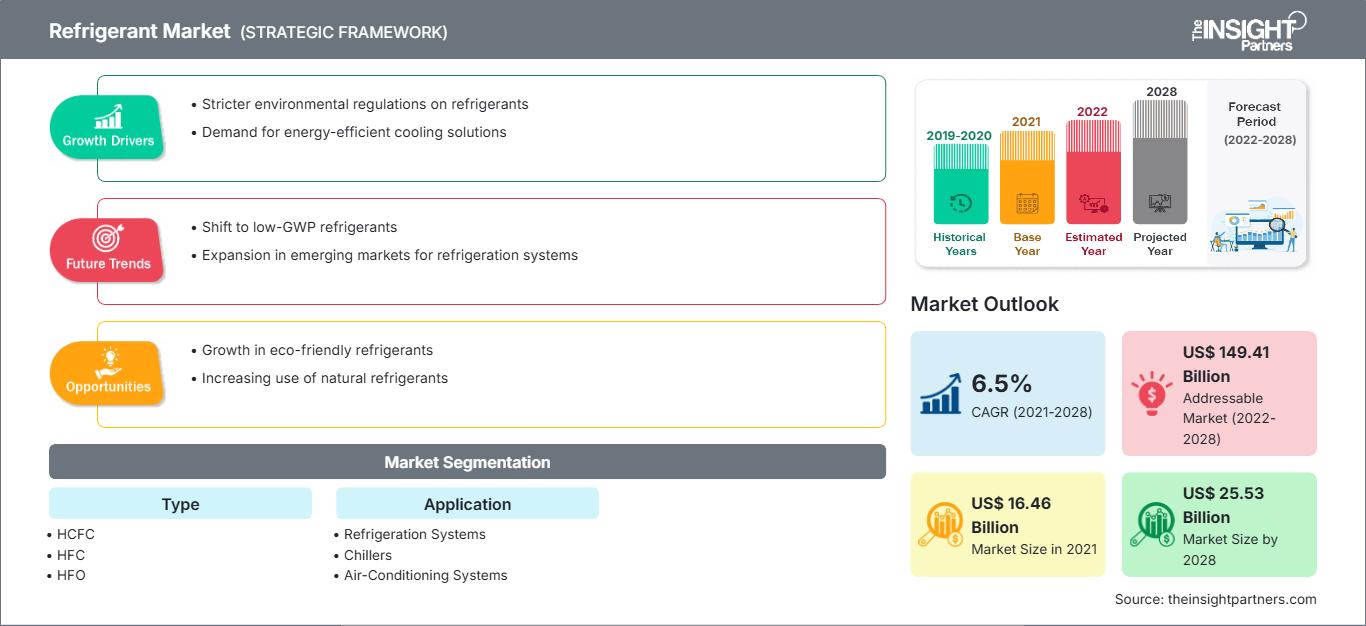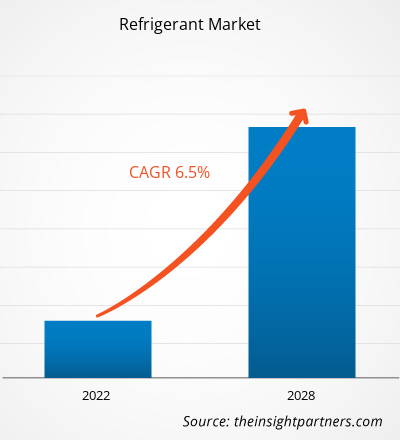Der Markt für Kältemittel wird bis 2031 voraussichtlich ein Volumen von 75,62 Milliarden US-Dollar erreichen, gegenüber 47,07 Milliarden US-Dollar im Jahr 2024. Es wird erwartet, dass der Markt im Zeitraum 2025–2031 eine durchschnittliche jährliche Wachstumsrate (CAGR) von 7,0 % verzeichnen wird.
Analyse des Kältemittelmarktes
Strenge Vorschriften wie die Kigali-Änderung und die schrittweise Reduzierung von F-Gasen beschleunigen den Prozess des Ersatzes von HFKW mit hohem GWP durch HFO mit niedrigem GWP, Mischungen aus HFO und HFKW sowie natürliche Kältemittel, einschließlich CO2, Ammoniak und Kohlenwasserstoffe. Das Volumen steigt im asiatisch-pazifischen Raum aufgrund der raschen Urbanisierung, des verbesserten Lebensstandards, des Wachstums der Kühlkettenlogistik, der Explosion von Rechenzentren und der Einführung von Elektrofahrzeugen. Die neue Generation von Leckageerkennungs-, Rückgewinnungssystemen und Geräten, die mit A2L kompatibel sind, ermöglicht sicherere Übergänge, ohne die Leistung, die Kosten und die Zuverlässigkeit ihrer Verwendung in Wohn-, Gewerbe-, Industrie- und Automobilanwendungen zu beeinträchtigen
Marktübersicht Kältemittel
Die universelle Anforderung an Kälte-, Klima- und Wärmepumpensysteme, die Leistung erbringen und die Umweltanforderungen erfüllen. Die installierte Basis muss noch durch HFOs (R-1234yf, R-1234ze), R-32 und natürliche Alternativen übertroffen werden. Der asiatisch-pazifische Raum war aufgrund des heißen Klimas, der Urbanisierung und der Industrialisierung in China und Indien am aktivsten im Verbrauch und in der Produktion. Die besten Übergänge werden in Europa und Nordamerika aufgrund strenger Gesetze erzwungen, während Entwicklungsländer einen Kompromiss zwischen Kosten und schrittweiser Einhaltung eingehen. Durch die Entwicklung umweltfreundlicherer Kältemittel, die Verbesserung der Konstruktion von Kühlsystemen und das ordnungsgemäße Recycling alter Kältemittel können Unternehmen ihre Produkte kontinuierlich verbessern und auch in Zukunft die gesetzlichen Bestimmungen einhalten
Passen Sie diesen Bericht Ihren Anforderungen an.
Sie erhalten eine kostenlose Anpassung aller Berichte – einschließlich Teilen dieses Berichts, Länderanalysen und Excel-Datenpaketen – sowie attraktive Angebote und Rabatte für Start-ups und Universitäten.
Kältemittelmarkt: Strategische Einblicke

-
Ermitteln Sie die wichtigsten Markttrends dieses Berichts.Diese kostenlose Probe beinhaltet eine Datenanalyse, die von Markttrends bis hin zu Schätzungen und Prognosen reicht.
Treiber und Chancen des Kältemittelmarktes
Markttreiber:
- Die Nachfrage ist gestiegen, insbesondere im Bereich der Klimaanlagen und Kühltechnik: Die Urbanisierung und die steigenden Einkommen im asiatisch-pazifischen Raum und im Nahen Osten treiben den Bedarf an intensiver Kühlung von Wohngebäuden, Gewerbeimmobilien und Fahrzeugen aufgrund des heißen Klimas voran.
- Strenge Umweltstandards: Die Kigali-Änderung, die EU-F-Gas-Gesetzgebung sowie nationale Ausstiegsprogramme für HFKW erfordern Ersatzstoffe mit niedrigem GWP.
- Boom bei der Nutzung von Elektrofahrzeugen und Rechenzentren: Der Einsatz von Wärmepumpen und Präzisionskühlsystemen nimmt rasant zu, was zu einem verstärkten Einsatz von Kältemitteln führt.
Marktchancen:
- Die nächste Generation von Kältemitteln mit niedrigem GWP: HFOs (R-1234yf/ze), A2L-Gemische und natürliche Kältemittel haben ein hohes Wachstumspotenzial als Ersatz.
- Wachsende Länder im asiatisch-pazifischen Raum: Langsame Ausstiegspläne und neue Anlagen treiben die Nachfrage nach Übergangskältemitteln und Kältemitteln mit niedrigem GWP an.
- Rückgewinnung, Recycling und Kreislaufwirtschaft: Fortschrittliche Märkte für die Rückgewinnung und Wiederaufbereitung von Kältemitteln tragen zur Sicherstellung von Nachhaltigkeit und Kostensenkung bei.
Marktsegmentierungsanalyse für Kältemittel
Der Kältemittelmarkt ist in verschiedene Segmente unterteilt, um einen besseren Überblick über sein Wachstumspotenzial und die neuesten Trends zu ermöglichen. Nachfolgend ist der in Branchenberichten übliche Segmentierungsansatz dargestellt:
Nach Typ:
- Ammoniak: Es ist ein hocheffizientes natürliches Kältemittel mit einem GWP von null; es wird am häufigsten in großen, industriellen Kälteanlagen verwendet, obwohl es giftig ist
- Kohlendioxid: Natürliches Kältemittel (GWP 1) ist umweltfreundlich und ersetzt in Supermärkten, Wärmepumpen und transkritischen kommerziellen Systemen zunehmend andere Kältemittel.
- Propan: Kohlenwasserstoffe mit hoher Effizienz (GWP 3) werden in kleinen Gewerbeeinheiten, Verkaufsautomaten und Steckdosenkästen eingesetzt.
- Isobutan: Ein Kohlenwasserstoff mit extrem niedrigem Treibhauspotenzial; es ist weltweit in Haushaltskühlschränken und -gefrierschränken Standard, da es Energie spart.
- HFKW: Große Mengen alter Kältemittel (R-410A, R-134a, R-404A) sind in bestehenden Systemen weiterhin weit verbreitet, werden aber weltweit schrittweise ersetzt.
- HFOs: HFC-Ersatz in Kfz- und Gewerbe-Klimaanlagen Synthetische Kältemittel der nächsten Generation mit niedrigem GWP (R-1234yf, R-1234ze, A2L-Mischungen); die am schnellsten wachsenden Alternativen zu HFCs.
- Andere: Übergangsmischungen (R-448A/R-449A, R-407-Serie), Nischen-Naturkohlenwasserstoffe und neue Kohlenwasserstoffe, die hauptsächlich bei Nachrüstungen und für spezielle Anwendungen zum Einsatz kommen.
Nach Anwendung:
- Kälteanlagen
- Kältemaschinen
- Klimaanlagen
- MACs
- Andere
Nach Endverwendung:
- Industriell
- Gewerblich
- Wohngebiet
- Andere
Nach Geografie:
- Nordamerika
- Europa
- Asien-Pazifik
- Naher Osten und Afrika
- Süd- und Mittelamerika
Regionale Einblicke in den Kältemittelmarkt
Die regionalen Trends und Einflussfaktoren auf den Kältemittelmarkt im gesamten Prognosezeitraum wurden von den Analysten von The Insight Partners ausführlich erläutert. Dieser Abschnitt behandelt außerdem die Marktsegmente und die geografische Verteilung des Kältemittelmarktes in Nordamerika, Europa, Asien-Pazifik, dem Nahen Osten und Afrika sowie Süd- und Mittelamerika.
Umfang des Kältemittelmarktberichts
| Berichtsattribute | Details |
|---|---|
| Marktgröße im Jahr 2024 | 47,04 Milliarden US-Dollar |
| Marktgröße bis 2031 | 75,62 Milliarden US-Dollar |
| Globale durchschnittliche jährliche Wachstumsrate (2025–2031) | 7,0 % |
| Historische Daten | 2021–2023 |
| Prognosezeitraum | 2025–2031 |
| Abgedeckte Segmente |
Nach Typ
|
| Abgedeckte Regionen und Länder |
Nordamerika
|
| Marktführer und wichtige Unternehmensprofile |
|
Kältemittelmarktteilnehmer Dichte: Auswirkungen auf die Geschäftsdynamik verstehen
Der Kältemittelmarkt wächst rasant, angetrieben durch die steigende Nachfrage der Endverbraucher. Gründe hierfür sind unter anderem sich wandelnde Verbraucherpräferenzen, technologische Fortschritte und ein wachsendes Bewusstsein für die Vorteile des Produkts. Mit steigender Nachfrage erweitern Unternehmen ihr Angebot, entwickeln innovative Lösungen für die Bedürfnisse der Verbraucher und nutzen neue Trends, was das Marktwachstum zusätzlich beflügelt.

- Verschaffen Sie sich einen Überblick über die wichtigsten Akteure des Kältemittelmarktes.
Analyse der Marktanteile von Kältemitteln nach Regionen
Die rasche Urbanisierung, steigende Einkommen und heiße Klimazonen schaffen eine enorme Nachfrage nach Klimaanlagen, Kühlkettenentwicklung und Kühlsystemen, was den Verbrauch von Kältemitteln ankurbelt. Neue Märkte in Lateinamerika und im Nahen Osten/Afrika haben aufgrund der Modernisierung des Lebensmitteleinzelhandels, der Exporte von Tiefkühlprodukten und eines späten HFKW-Ausstiegsplans ein gutes zukünftiges Entwicklungspotenzial
Das Wachstum des Kältemittelmarktes variiert je nach Region aufgrund des unterschiedlichen Wirtschaftswachstums und der individuellen Verbraucherpräferenzen. Nachfolgend finden Sie eine Zusammenfassung der Marktanteile und Trends nach Regionen:
1. Nordamerika
- Marktanteil: Kontrolliert einen beträchtlichen Teil des Kältemittelmarktes
-
Wichtigste Treiber:
- Gewerbliche Kälteanlagen und Klimaanlagen in Wohnhäusern.
- Keine laschen EPA-HFKW-Abbaumaßnahmen und Anforderungen an niedriges Treibhauspotenzial
- Trends: Schnelle Umstellung auf A2L-HFO-Gemische und CO2-Kaskadensysteme
2. Europa
- Marktanteil: Großer Anteil, der durch frühe und aggressive Regulierung begünstigt wurde
-
Wichtigste Treiber:
- Strenge EU-F-Gas-Quoten und HFKW-Verbote ab 2030.
- Gute Supermarkt- und Wärmepumpen-Einführung
- Trends: Die zunehmende Verwendung natürlicher Kältemittel (CO2, Propan) und die Führungsrolle von HFO
3. Asien-Pazifik
- Marktanteil: Die am schnellsten wachsende Region mit einem rapide steigenden Marktanteil
-
Wichtigste Treiber:
- Enormer Wechselstrombedarf, Urbanisierung und der Ausbau der Kühlkette.
- HFKW-Produktion und -Verbrauch in China/Indien
- Trends: Anhaltender HFKW-Verbrauch und zunehmender Einsatz von R-32 und HFO/HFKW-Gemischen
4. Naher Osten und Afrika
- Marktanteil: Wachsender Markt mit stabilem Wachstum
-
Wichtigste Treiber:
- Der Bedarf an Klimaanlagen und Kühlgeräten ist auf extreme Klimabedingungen zurückzuführen.
- Die späte Phase ist in den Ländern der Artikel 5 rückläufig.
- Trends: Hohe Nachfrage nach kostengünstigen HFKW und Mischungen
5. Süd- und Mittelamerika
- Marktanteil: Kleinerer und schnell wachsender Markt
-
Wichtigste Treiber:
- Entwicklung der Kühlkette im Lebensmittel- und Einzelhandelsexport.
- Fortschritte bei AC-Intrusionen und regulatorischer Korrelation mit Kigali
- Trends: Ersatz von R-404A/R-22 durch HFO-Lösungen mit niedrigerem GWP und Ersatz von R-290/R-600a-Lösungen durch HFO-Lösungen mit niedrigerem GWP.
Kältemittelmarktteilnehmer Dichte: Auswirkungen auf die Geschäftsdynamik verstehen
Hohe Marktdichte und starker Wettbewerb
Der Wettbewerb ist aufgrund der Präsenz etablierter Akteure wie Archer-Daniels-Midland Company, Didion Milling Inc, KRONER-STÃRKE GmbH, Tardella Flour Co Inc und LifeLine Foods LLC intensiv.
Dieser hohe Wettbewerbsdruck zwingt Unternehmen dazu, sich durch Folgendes hervorzuheben:
- Zukünftige Innovationen zur Entwicklung von HFOs der nächsten Generation mit niedrigem GWP, A2L-Gemischen und natürlichen Kältemittellösungen mit höherer Effizienz und Sicherheit.
- Kommunikation kosteneffizienter, sofort einsatzbereiter und nachrüstbarer Mischungen, um die Nutzung der bereits vorhandenen HFKW-Systeme zu verlängern und die Ausstiegspläne einzuhalten.
- Das Angebot fortschrittlicher Rückgewinnungs-, Verwertungs- und Kreislaufwirtschaftsdienstleistungen zur Reduzierung des Bedarfs an neuem Kältemittel und der Emissionen.
Chancen und strategische Schritte
- Einführung neuer Anlagen auf Basis von PHFO mit extrem niedrigem Treibhauspotenzial und natürlichen Kältemitteln.
- Steigerung der Produktion von R-32- und R-454-Gemischen sowie von R-1234yf/ze, um den Ersatzmarkt zu erobern.
- Leckageerkennungssysteme für Lagerbestände, IoT-Überwachung und intelligente Kühlschranksysteme.
- Zusammenarbeit mit OEMs bei A2L- und CO2-kompatiblen Geräten.
- Zusammenarbeit mit Regierungen und der Industrie bei der Ausbildung, den Sicherheitsstandards und den groß angelegten Sanierungsprogrammen.
Die wichtigsten Unternehmen, die auf dem Kältemittelmarkt tätig sind, sind:
- A-Gas International Limited
- Eastman Chemical Co
- Eastman Chemical Co
- Arkema SA
- Linde Plc
- Honeywell International Inc.
- Daikin Industries Ltd.
- Air Liquide
- Orbia
- Quimobasicos SA de CV
Hinweis: Die oben aufgeführten Unternehmen sind nicht in einer bestimmten Reihenfolge geordnet.
Weitere im Rahmen der Studie analysierte Unternehmen:
- Didion Milling Inc.
- KRONER-STÃRKE GmbH
- Tardella Flour Co. Inc.
- LifeLine Foods LLC
- Sage V Foods LLC
- Agrasys SL
- Caremoli-Gruppe
- BELOURTHE SA
Neuigkeiten und aktuelle Entwicklungen auf dem Kältemittelmarkt
- A-Gas erweitert Geschäftstätigkeit in Kanada: A-Gas International Limited hat in Hamilton, Ontario, ihre erste kanadische Anlage zur Rückgewinnung und Wiederaufbereitung von Kältemitteln errichtet. Die Anlage, die im vierten Quartal des Jahres in Betrieb ging, verarbeitet und gewinnt Kältemittel gemäß den AHRI-700-Standards zurück.
- Arkema stärkt sein Angebot an Kältemitteln mit geringerem Treibhauspotenzial: Arkema SA kündigte die Erweiterung seines Angebots an Kältemitteln mit niedrigem Treibhauspotenzial (GWP) durch eine kommerzielle Partnerschaft mit Honeywell an. Ziel dieser Zusammenarbeit ist die Optimierung globaler Lieferketten und die Deckung der steigenden Nachfrage nach HFO-Gemischen in der HLK-Branche, im Einklang mit dem schrittweisen Ausstieg aus HFKW.
Bericht über den Kältemittelmarkt: Abdeckung und Ergebnisse
Der Bericht „Marktgröße und Prognose für Kältemittel (2021–2031)“ bietet eine detaillierte Analyse des Marktes und deckt folgende Bereiche ab:
- Marktgröße und Prognose für Kältemittel auf globaler, regionaler und Länderebene für alle im Geltungsbereich abgedeckten Marktsegmente
- Trends im Kältemittelmarkt sowie Marktdynamiken wie Treiber, Hemmnisse und wichtige Chancen
- Detaillierte Analyse der fünf Wettbewerbskräfte nach Porter und SWOT-Analyse
- Analyse des Kältemittelmarktes mit Fokus auf Markttrends, globale und regionale Rahmenbedingungen, Hauptakteure, regulatorische Rahmenbedingungen und aktuelle Marktentwicklungen
- Branchenlandschafts- und Wettbewerbsanalyse mit Fokus auf Marktkonzentration, Heatmap-Analyse, führende Akteure und aktuelle Entwicklungen im Kältemittelmarkt
- Detaillierte Firmenprofile
- Historische Analyse (2 Jahre), Basisjahr, Prognose (7 Jahre) mit CAGR
- PEST- und SWOT-Analyse
- Marktgröße Wert/Volumen – Global, Regional, Land
- Branchen- und Wettbewerbslandschaft
- Excel-Datensatz
Aktuelle Berichte
Erfahrungsberichte
Grund zum Kauf
- Fundierte Entscheidungsfindung
- Marktdynamik verstehen
- Wettbewerbsanalyse
- Kundeneinblicke
- Marktprognosen
- Risikominimierung
- Strategische Planung
- Investitionsbegründung
- Identifizierung neuer Märkte
- Verbesserung von Marketingstrategien
- Steigerung der Betriebseffizienz
- Anpassung an regulatorische Trends






















 Kostenlose Probe anfordern für - Kältemittelmarkt
Kostenlose Probe anfordern für - Kältemittelmarkt